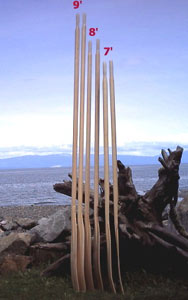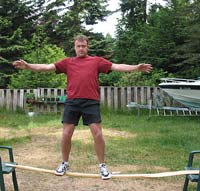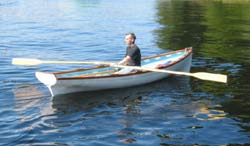Choosing Your Perfect Oars
By Paul
Bagshaw
 One
may ask "why row"? There are many reasons ranging from
pleasure to neccessity, but finding the type of oar you need can
be daunting to the newcomer as there are many different designs,
lengths, and wood types available. One
may ask "why row"? There are many reasons ranging from
pleasure to neccessity, but finding the type of oar you need can
be daunting to the newcomer as there are many different designs,
lengths, and wood types available.
The 1st thing to sort out is, what
length of oar do you need. The general rule of thumb is usually
twice the beam of the boat or the following formula can be used
for a more accurate measurement: Measure the beam of your boat
between the locks in inches, divide by 2, add 2, divide by 7 then
multiply by 25. This will give a rough idea of the length of oar
needed in inches.
There are many other things to
consider for determining the proper length and this can make a
large difference in the comfort and efficiency of your oars. If
the boat is easily propelled through the water and requires little
effort to get moving ie. sculls, wherry's, whitehalls, glouchester
dory, etc. - anything with fine lines, you will want a longer
oar to keep pace with the faster speed travelled through the water.
Outriggers and sliding seats can also let you use a substantially
longer oar if you are rowing a narrow fine-lined hull. At the
opposite end of the spectrum is the oar that is used in river
rafting or backup propulsion for sailboats, aluminum and fiberglass
fishing boats, etc. Fundamentally any slow moving vessel that
has a lot of mass and displacement and requires a substantial
effort to keep the vessel making progress will need a more robust,
shorter oar if possible. It all boils down to fulcrum and leverage
points and trying to produce a rowing pace of 20-30 strokes per
minute.
 Shaft
flex is another important aspect to consider. A oar with very
little flex can be hard on the joints and tendons over a longer
session of rowing. Having a bit of flex at the end of the stroke
creates a nice "kick" for that extra push, but you must
take into consideration durability as well. A broken oar will
only leave you rowing in circles, which brings us to the fact
that one should always carry 3 or more oars onboard at all times
because oars can break or get lost overboard. We offer a 20% discount
on the 3rd oar if you decide you need a backup. Shaft
flex is another important aspect to consider. A oar with very
little flex can be hard on the joints and tendons over a longer
session of rowing. Having a bit of flex at the end of the stroke
creates a nice "kick" for that extra push, but you must
take into consideration durability as well. A broken oar will
only leave you rowing in circles, which brings us to the fact
that one should always carry 3 or more oars onboard at all times
because oars can break or get lost overboard. We offer a 20% discount
on the 3rd oar if you decide you need a backup.
 The
styles of oars available for use are generally the flat (tradional)
blade or spoon (cupped) blade oar. The spoon blade is 33% more
efficient as it holds the water for 30 degrees of the stroke compared
to the flat blade that holds it for 20 degrees. Obviously if you
are doing a lot of back strokes on the oars, ie. river rafters,
a flat blade is a much better choice. The cost of a spoon blade
is well worth the extra money if oars are the main form of propulsion
for your boat and backstrokes are rarely used. The
styles of oars available for use are generally the flat (tradional)
blade or spoon (cupped) blade oar. The spoon blade is 33% more
efficient as it holds the water for 30 degrees of the stroke compared
to the flat blade that holds it for 20 degrees. Obviously if you
are doing a lot of back strokes on the oars, ie. river rafters,
a flat blade is a much better choice. The cost of a spoon blade
is well worth the extra money if oars are the main form of propulsion
for your boat and backstrokes are rarely used.
Wood types are another major concern
to help decipher the perfect oar for your application. The most
common species of wood used in oar construction are spruce, fir
and ash, spruce being the lightest and most popular. The fir and
ash are used primarily for river rafting and high stress applications
where strength rather than weight is the priority. Hybrid oars
are another good option as well, if you are river rafting in calm
water but occasionally come into contact with rocks, a spruce
shaft with ash blades would make an excellent choice.
 You
should also make sure there are few if any knots in the oar, although
a few pinhole knots will not affect the overall integrity. The
grain of the oar shaft should be 90 degrees to the blade or run
in the same direction as the sweep of the oar and the blades grain
should also run vertically through the blade. You
should also make sure there are few if any knots in the oar, although
a few pinhole knots will not affect the overall integrity. The
grain of the oar shaft should be 90 degrees to the blade or run
in the same direction as the sweep of the oar and the blades grain
should also run vertically through the blade.
I prefer an unvarnished handle
as they are less prone to causing callouses but you must take
care that the oars are not left in the elements too long. Another
option is the foam grip that slides over the handle as they form
nicely to the hand and offer a cushioning effect as well.
Hopefully this will help
you to find your "perfect" oar and that you use them
to log many enjoyable miles under your keel. |

